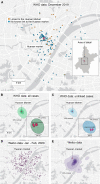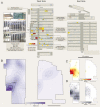The Huanan Seafood Wholesale Market in Wuhan was the early epicenter of the COVID-19 pandemic
- PMID: 35881010
- PMCID: PMC9348750
- DOI: 10.1126/science.abp8715
The Huanan Seafood Wholesale Market in Wuhan was the early epicenter of the COVID-19 pandemic
Erratum in
-
Erratum for the Research Article "The Huanan Seafood Wholesale Market in Wuhan was the early epicenter of the COVID-19 pandemic" by M. Worobey et al.Science. 2024 Mar 15;383(6688):eadp1133. doi: 10.1126/science.adp1133. Epub 2024 Mar 14. Science. 2024. PMID: 38484083 Free PMC article. No abstract available.
Abstract
Understanding how severe acute respiratory syndrome coronavirus 2 (SARS-CoV-2) emerged in 2019 is critical to preventing future zoonotic outbreaks before they become the next pandemic. The Huanan Seafood Wholesale Market in Wuhan, China, was identified as a likely source of cases in early reports, but later this conclusion became controversial. We show here that the earliest known COVID-19 cases from December 2019, including those without reported direct links, were geographically centered on this market. We report that live SARS-CoV-2-susceptible mammals were sold at the market in late 2019 and that within the market, SARS-CoV-2-positive environmental samples were spatially associated with vendors selling live mammals. Although there is insufficient evidence to define upstream events, and exact circumstances remain obscure, our analyses indicate that the emergence of SARS-CoV-2 occurred through the live wildlife trade in China and show that the Huanan market was the epicenter of the COVID-19 pandemic.
Figures





Comment in
-
Wildlife trade is likely the source of SARS-CoV-2.Science. 2022 Aug 26;377(6609):925-926. doi: 10.1126/science.add8384. Epub 2022 Aug 25. Science. 2022. PMID: 36007033
References
-
- Sina Finance, “Wuhan pneumonia of unknown cause cases isolated, test results to be announced ASAP” (Sina Finance, 2019); https://finance.sina.cn/2019-12-31/detail-iihnzahk1074832.d.html?from=wap.
-
- Wuhan Municipal Health Commission, “Wuhan Municipal Health Commission’s briefing on the current situation of pneumonia in our city” (Wuham Municipal Health Commission, 2019); https://web.archive.org/web/20200131202951/http:/wjw.wuhan.gov.cn/front/....
-
- World Health Organization, “COVID-19 – China” (WHO, 2020); https://www.who.int/emergencies/disease-outbreak-news/item/2020-DON229.
MeSH terms
Grants and funding
- U19 AI135995/AI/NIAID NIH HHS/United States
- R01 AI153044/AI/NIAID NIH HHS/United States
- R01 AI132223/AI/NIAID NIH HHS/United States
- U54 CA260581/CA/NCI NIH HHS/United States
- MC_PC_19026/MRC_/Medical Research Council/United Kingdom
- WT_/Wellcome Trust/United Kingdom
- R01 AI132244/AI/NIAID NIH HHS/United States
- R01 AI135992/AI/NIAID NIH HHS/United States
- R01 AI136056/AI/NIAID NIH HHS/United States
- U19 AI142790/AI/NIAID NIH HHS/United States
- T15 LM011271/LM/NLM NIH HHS/United States
- MC_UU_12014/12/MRC_/Medical Research Council/United Kingdom
- T32 AI007244/AI/NIAID NIH HHS/United States
- F32 AI152341/AI/NIAID NIH HHS/United States
- 75N93021C00015/AI/NIAID NIH HHS/United States
- UL1 TR002550/TR/NCATS NIH HHS/United States
- U01 AI151812/AI/NIAID NIH HHS/United States
- U54 HG007480/HG/NHGRI NIH HHS/United States
LinkOut - more resources
Full Text Sources
Other Literature Sources
Medical
Miscellaneous

